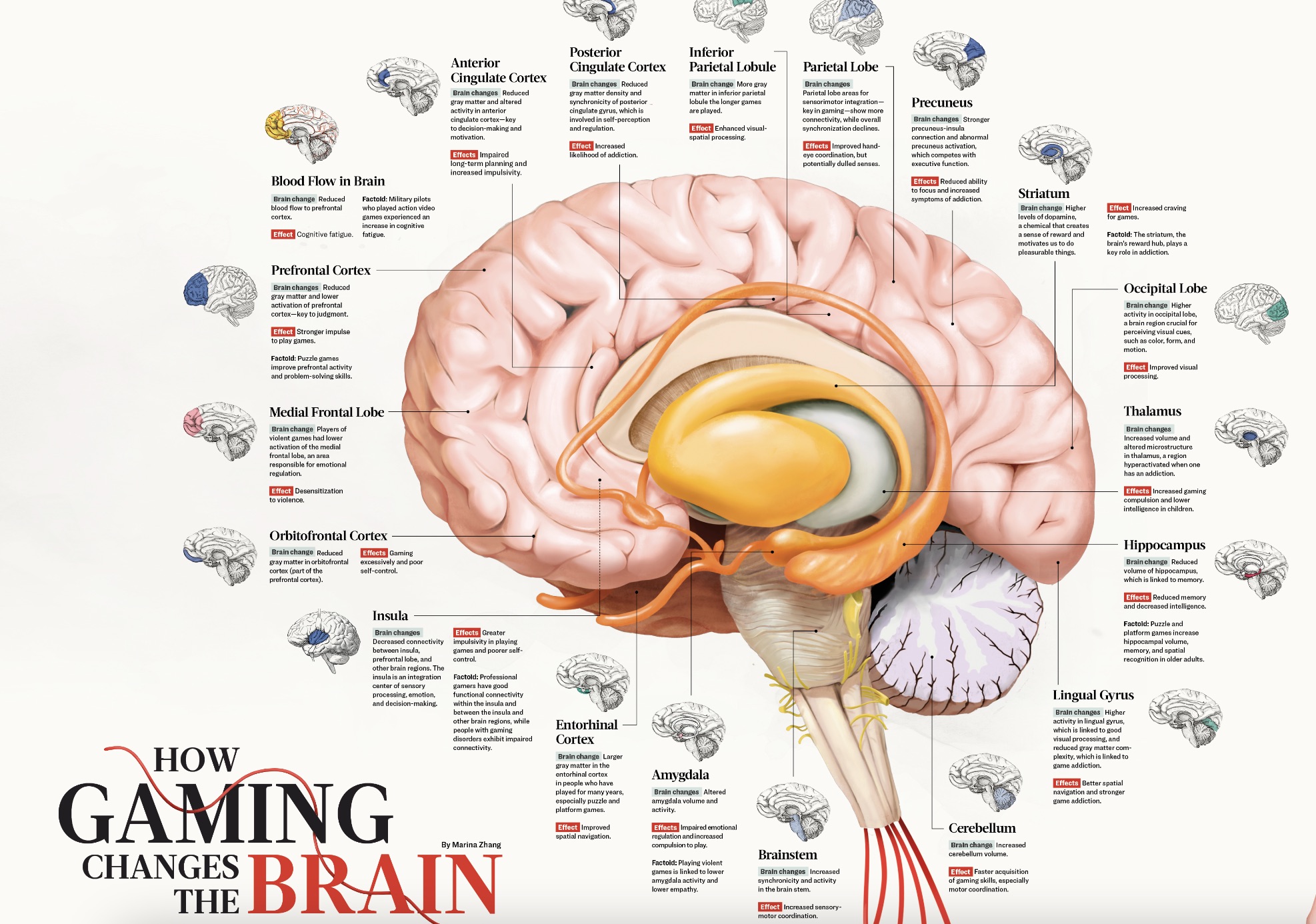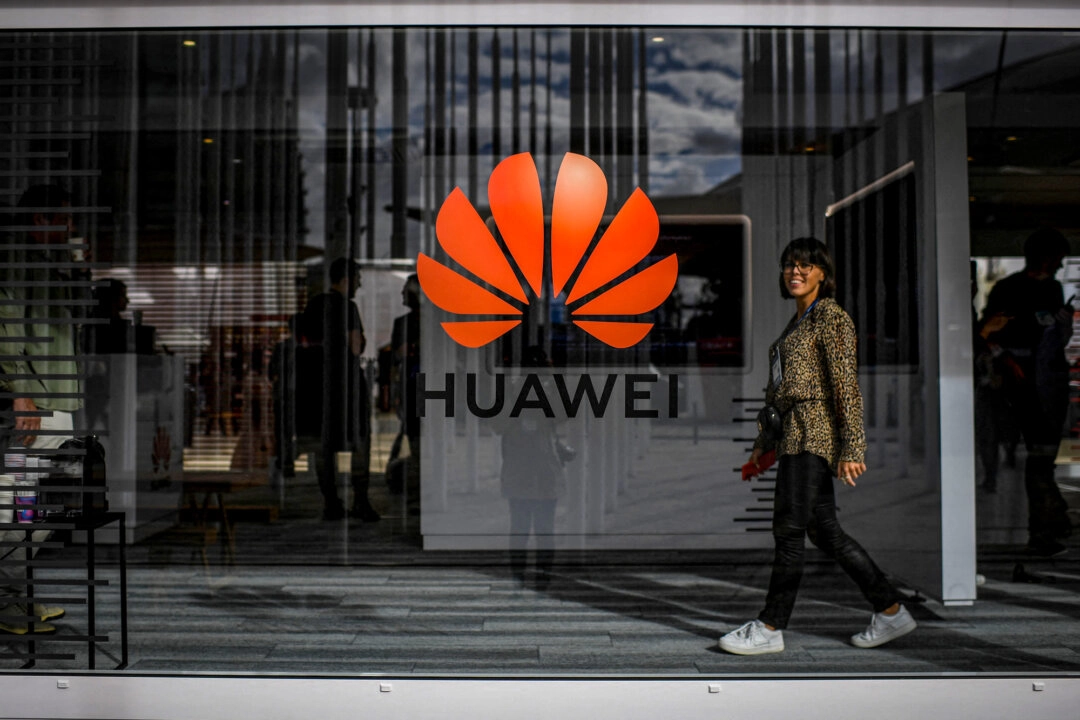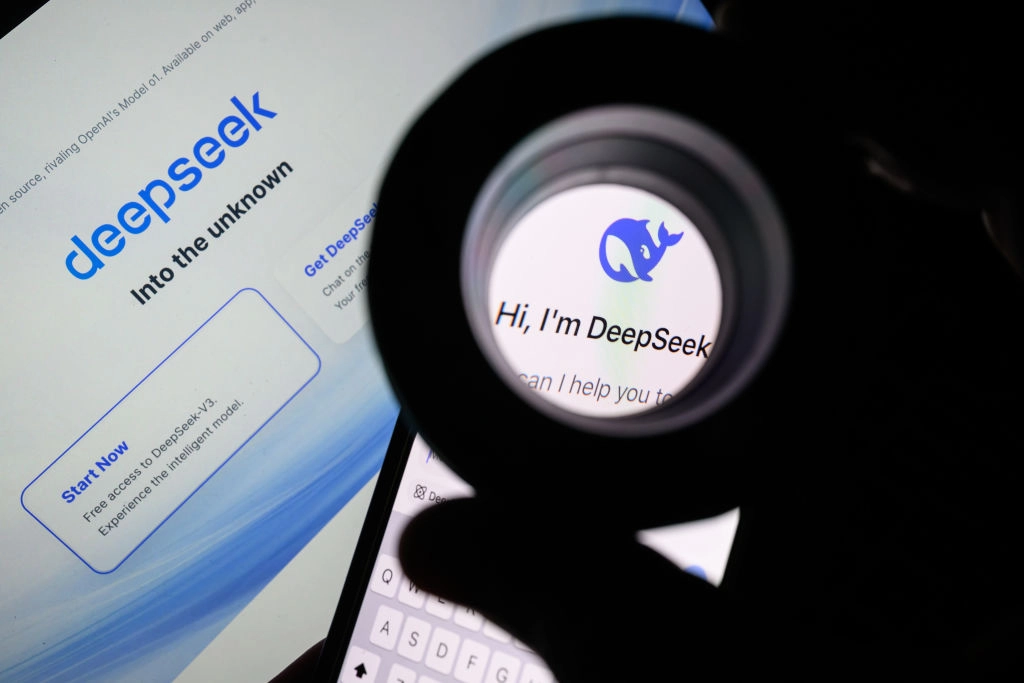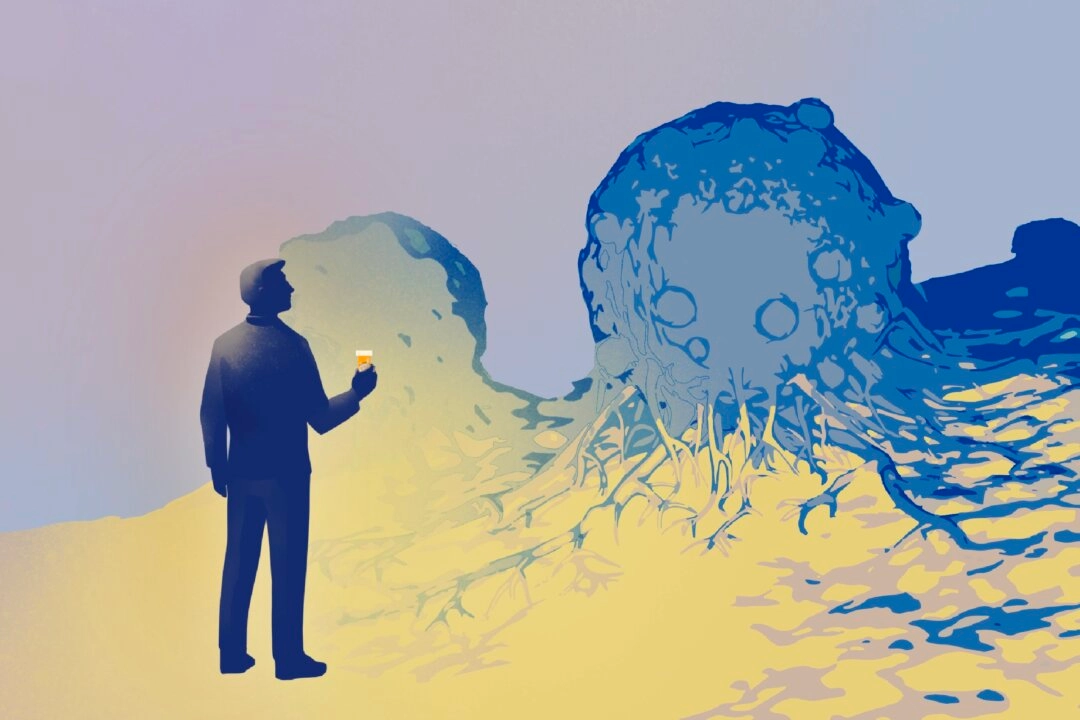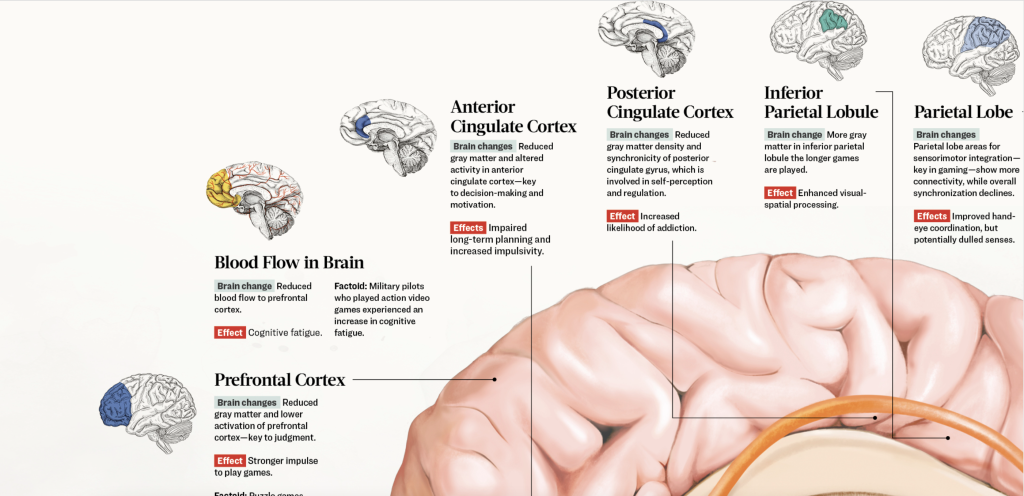
Από δεξιά προς τα αριστερά
Βρεγματικός λοβός (Parietal lobe)
Εγκεφαλικές αλλαγές
Περιοχές του βρεγματικού λοβού σχετικές με συνεργασία οπτικού ερεθίσματος και κίνησης —κάτι σημαντικό στα βιντεοπαιχνίδια— δείχνουν περισσότερη συνδεσιμότητα, ενώ ο γενικός συγχρονισμός μειώνεται.
Επιδράσεις
Η συνεργασία οφθαλμού-χεριού βελτιώνεται, αλλά πιθανώς αμβλυμένες αισθήσεις.
Ελάσσων βρεγματικός λοβός
Εγκεφαλικές αλλαγές
Περισσότερη φαιά ουσία στον ελάσσονα βρεγματικό λοβό όσο περισσότερο παίζονται τα παιχνίδια.
Επιδράσεις
Ενισχυμένη οπτο-χωρική επεξεργασία.
Οπίσθιος κυλινδρικός φλοιός
Εγκεφαλικές αλλαγές
Μειωμένη πυκνότητα φαιάς ουσίας και συγχρονισμού της οπίσθιας κυλινδρικής έλικας, η οποία συμμετέχει στην αντίληψη του εαυτού και στην αυτοπειθαρχία.
Επιδράσεις
Αυξημένη πιθανότητα εθισμού.
Εμπρόσθιος κυλινδρικός φλοιός
Εγκεφαλικές αλλαγές
Μειωμένη φαιά ουσία και αλλαγμένη δραστηριότητα του εμπρόσθιου κυλινδρικού φλοιού—κρίσιμη στη λήψη αποφάσεων και στην αίσθηση κινήτρου.
Επιδράσεις
Μειωμένη ικανότητα μακροπρόθεσμου προγραμματισμού και αυξημένη παρορμητικότητα.
Προμετωπιαίος φλοιός
Εγκεφαλικές αλλαγές
Μειωμένη φαιά ουσία και χαμηλότερη ενεργοποίηση του προμετωπιαίου φλοιού—σημαντικό στην κρίση.
Επιδράσεις
Δυνατότερη παρόρμηση να παίξεις βιντεοπαιχνίδια.
Λεπτομέρεια
Παιχνίδια παζλ αυξάνουν την προμετωπιαία δραστηριότητα και την ικανότητα επίλυσης προβλημάτων.
Έσω μετωπιαίος λοβός
Εγκεφαλικές αλλαγές
Παίκτες βίαιων βιντεοπαιχνιδιών είχαν χαμηλότερη ενεργοποίηση του έσω μετωπιαίου λοβού, μια περιοχή υπεύθυνη για τη συναισθηματική διαχείριση.
Επιδράσεις
Αναισθησία στην βία.
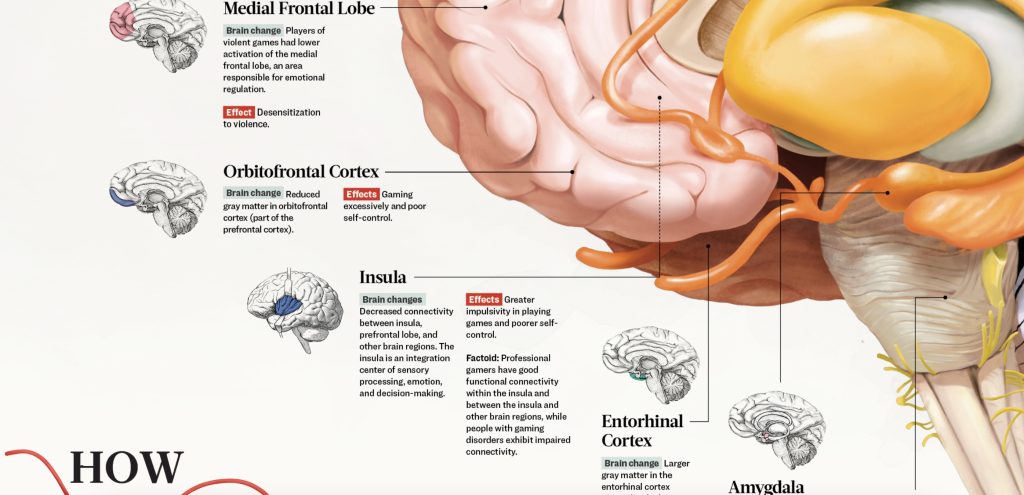
Κογχομετωπιαίος φλοιός
Εγκεφαλικές αλλαγές
Μειωμένη φαιά ουσία στον κογχομετωπιαίο φλοιό (μέρος του προμετωπιαίου λοβού).
Επιδράσεις
Υπερβολική χρήση βιντεοπαιχνιδιού και κακός αυτοέλεγχος.
Νησιωτικός φλοιός
Εγκεφαλικές αλλαγές
Μειωμένη συνδεσιμότητα μεταξύ νησιωτικού φλοιού, προμετωπιαίου λοβού και άλλων τμημάτων του εγκεφάλου. Ο νησιωτικός φλοιός είναι ένα κέντρο ενοποίησης για αισθητηριακή επεξεργασία, συναίσθημα, και λήψη αποφάσεων.
Επιδράσεις
Μεγαλύτερη παρορμητικότητα για χρήση βιντεοπαιχνιδιών και χειρότερος αυτοέλεγχος.
Λεπτομέρεια
Αυτοί που παίζουν ως επάγγελμα έχουν καλή λειτουργική συνδεσιμότητα μέσα στον νησιωτικό φλοιό και μεταξύ του νησιωτικού φλοιού και άλλων περιοχών του εγκεφάλου, ενώ άτομα με παρενέργειες από το παιχνίδι έχουν επιβαρυμένη συνδεσιμότητα.
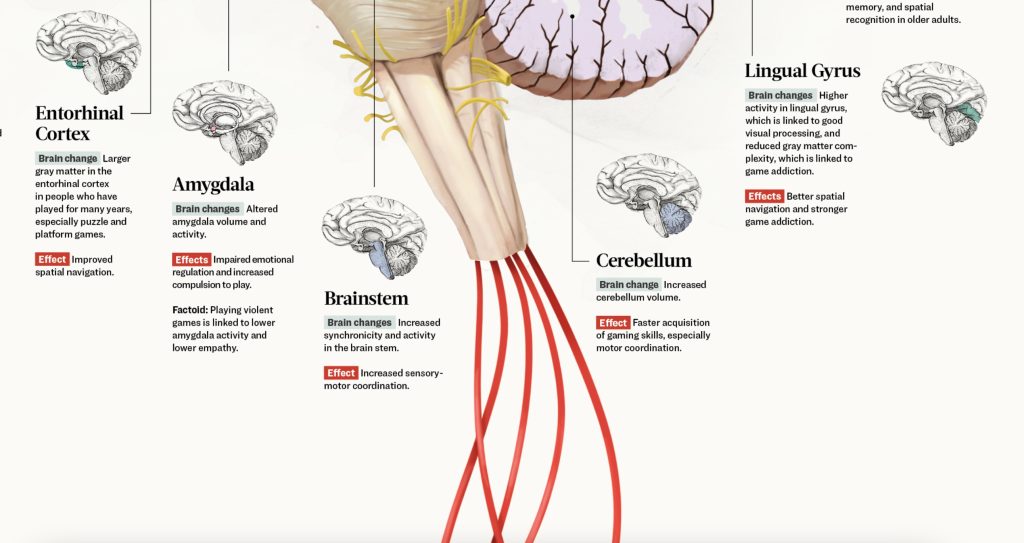
Ενδορινικός φλοιός
Εγκεφαλικές αλλαγές
Μεγαλύτερη φαιά ουσία σε ανθρώπους που έχουν παίξει για πολλά χρόνια, ειδικά παζλ και παιχνίδια πλατφόρμας.
Επιδράσεις
Βελτιωμένη χωρική περιήγηση.
Αμυγδαλή
Εγκεφαλικές αλλαγές
Αλλαγμένος όγκος και δραστηριότητα αμυγδαλής.
Επιδράσεις
Μειωμένη συναισθηματική διαχείριση και αυξημένη επιθυμία για παιχνίδι.
Λεπτομέρεια
Τα βίαια παιχνίδια οδηγούν σε μειωμένη δραστηριότητα αμυγδαλής και λιγότερη καλοσύνη.
Εγκεφαλικό στέλεχος
Εγκεφαλικές αλλαγές
Αυξημένος συγχρονισμός και δραστηριότητα στο εγκεφαλικό στέλεχος.
Επιδράσεις
Αυξημένος συντονισμός αισθητηρίου-κίνησης.
Ροή αίματος στον εγκέφαλο
Εγκεφαλική αλλαγή
Μειωμένη ροή αίματος στον προμετωπιαίο λοβό.
Επίδραση
Νοητική κόπωση.
Λεπτομέρεια
Στρατιωτικοί πιλότοι που έκαναν χρήση παιχνιδιών δράσης είχαν αυξημένη νοητική κόπωση.
Precuneus (πρόδρομος)
Εγκεφαλικές αλλαγές
Ισχυρότερη σύνδεση precuneus-νησιωτικού φλοιού και ανώμαλη ενεργοποίηση του precuneus, που αντιτίθεται στην εκτελεστική λειτουργία.
Επιδράσεις
Μειωμένη ικανότητα συγκέντρωσης και αυξημένα συμπτώματα εθισμού.
Ινιακός λοβός
Εγκεφαλική αλλαγή
Μεγαλύτερη δραστηριότητα στον ινιακό λοβό, ακόμα και κατά την ανάπαυση, και ισχυρότερη σύνδεση με τον βρεγματικό λοβό και με τις περιοχές αίσθησης και κίνησης.
Επίδραση
Αυξημένη οπτική επεξεργασία.
Ραβδωτό σώμα
Εγκεφαλική αλλαγή
Υψηλότερα επίπεδα ντοπαμίνης, ενός χημικού που δημιουργεί αίσθηση επιβράβευσης και μας κινητοποιεί να κάνουμε πράγματα που δίνουν απόλαυση.
Επίδραση
Αυξημένη ισχυρής έντασης επιθυμία για παιχνίδια.
Λεπτομέρεια
Το ραβδωτό σώμα, το κέντρο επιβράβευσης του εγκεφάλου, παίζει κρίσιμο ρόλο στον εθισμό.
Θάλαμος
Εγκεφαλικές αλλαγές
Αυξημένος όγκος και αλλαγμένη μικροδομή στον θάλαμο, μια περιοχή υπερενεργοποιημένη όταν κάποιος έχει εθισμό.
Επίδραση
Αυξημένη παρόρμηση για παιχνίδια και χαμηλότερη ευφυία σε παιδιά.
Γλωσσική έλικα
Εγκεφαλικές αλλαγές
Αυξημένη δραστηριότητα στην γλωσσική έλικα, η οποία συνδέεται με καλή οπτική επεξεργασία, και μειωμένη πολυπλοκότητα φαιάς ουσίας, που συνδέεται με εθισμό στο παιχνίδι.
Επίδραση
Καλύτερη χωρική περιήγηση και δυνατότερος εθισμός στο παιχνίδι.
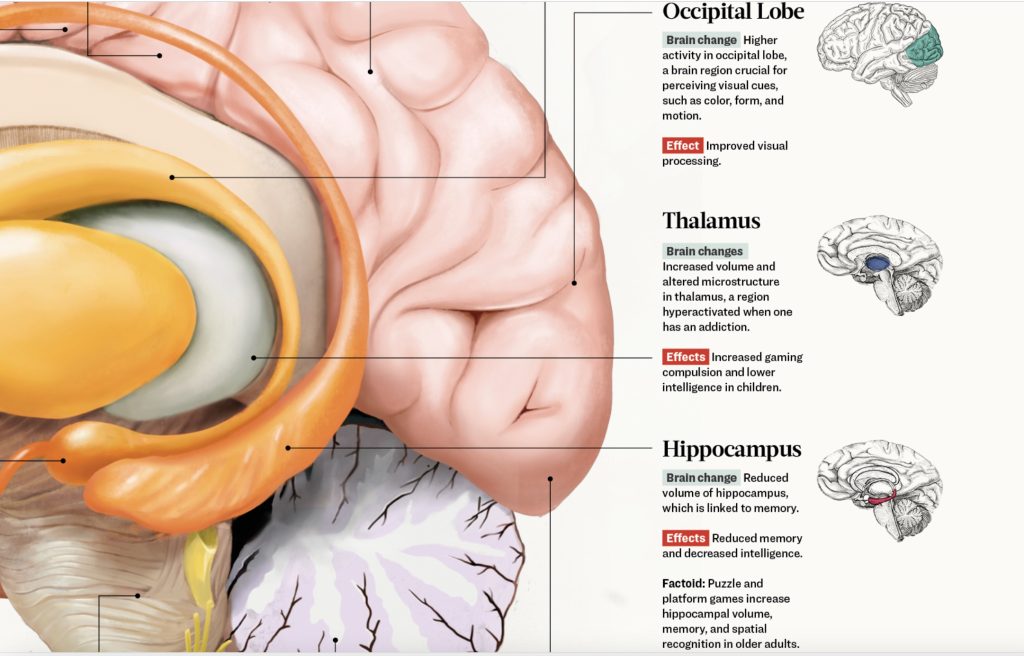
Ιππόκαμπος
Εγκεφαλική αλλαγή
Μειωμένος όγκος του ιππόκαμπου, που συνδέεται με την μνήμη.
Επίδραση
Μειωμένη μνήμη και μειωμένη ευφυία.
Λεπτομέρεια
Παιχνίδια παζλ και πλατφόρμας αυξάνουν τον όγκο του ιππόκαμπου, την μνήμη, και την χωρική αναγνώριση σε ηλικιωμένους ενηλίκους.
Παρεγκεφαλίδα
Εγκεφαλική αλλαγή
Αυξημένος όγκος παρεγκεφαλίδας.
Επίδραση
Ταχύτερη απόκτηση ικανοτήτων παιχνιδιών, ειδικά συντονισμός κίνησης.
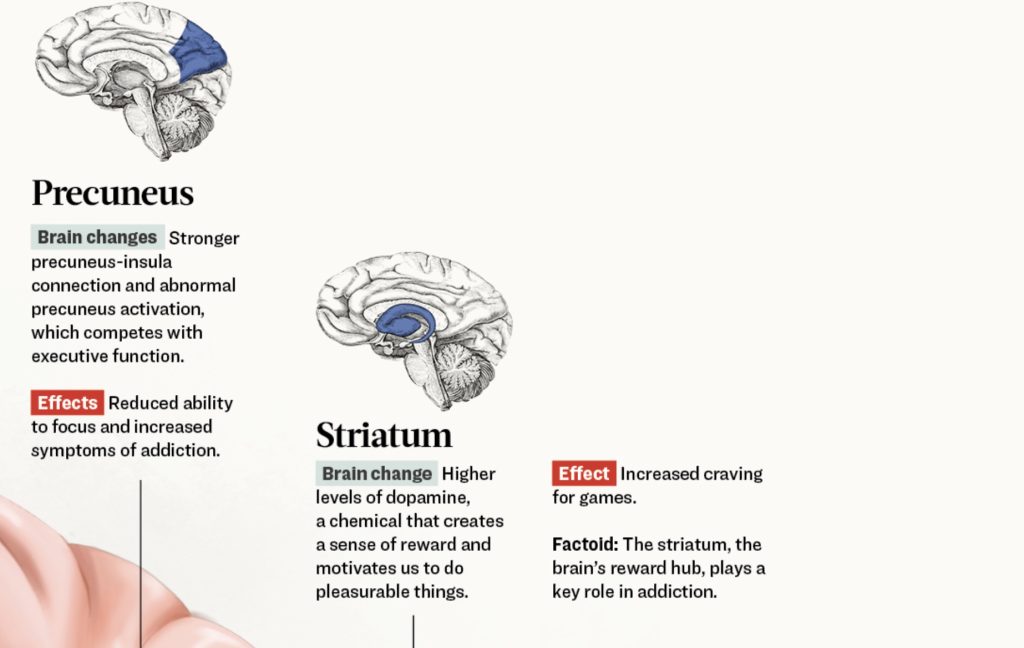
Σχεδιασμός παιχνιδιού

Η εικόνα 6 δείχνει τρεις φάσεις ενός βιντεοπαιχνιδιού:
1. Αφότου ο παίκτης βγει από μια σπηλιά-πύλη σε έναν νέο κόσμο, φως εμφανίζεται πίσω του.
2. Ο παίκτης βρίσκει ένα σεντούκι θησαυρού μετά από 10 λεπτά εξερεύνησης. Όταν το ανοίγει, κερδίζει ένα σπαθί ως ανταμοιβή.
3. Ο παίκτης μάχεται με έναν αρχηγό. Το επίπεδο δυσκολίας της μάχης είναι προσεκτικά σχεδιασμένο για να βελτιώσει την εμπειρία του παίκτη.
Αυτές οι φάσεις αντιστοιχούν σε τρεις βασικές στρατηγικές που έχουν ως στόχο να κρατούν τους παίκτες σε κατάσταση επιθυμίας.
1.Αισθητική
Το χρώμα, η γενική αίσθηση και τα ηχητικά εφέ που έχουν σχεδιαστεί για να ταιριάζουν με το εγγενές σύνολο κανόνων του εγκεφάλου, δίνουν στους χρήστες μια αίσθηση ανταμοιβής μέσω ελέγχου επί του παιχνιδιού, ξεγελώντας τον εγκέφαλο ώστε να αντιλαμβάνεται τον κόσμο του παιχνιδιού ως πραγματικό και γοητευτικό.
2. Ανταμοιβή
Τυχαίες ανταμοιβές εντός του παιχνιδιού που οι χρήστες κερδίζουν αφότου νικήσουν έναν αρχηγό, ανέβουν επίπεδο, ή εξερευνήσουν τον κόσμο του παιχνιδιού. Η απρόβλεπτη φύση της ανταμοιβής ωθεί τους χρήστες να συνεχίσουν να παίζουν και ενισχύει την παρορμητική συμπεριφορά.
3. Κατάσταση ροής
Τα επίπεδα δυσκολίας του παιχνιδιού φτιάχνονται ώστε να ταιριάζουν με τις ικανότητες των χρηστών επιτυγχάνοντας μια ισορροπία όπου οι χρήστες μπαίνουν σε τέτοια συγκέντρωση που ο χρόνος περνά πολύ γρήγορα. Σε αυτήν την κατάσταση, εγκεφαλικές περιοχές όπως ο κογχομετωπιαίος φλοιός, ο πρόσθιος κυλινδρικός φλοιός, και ο πρόδρομος απενεργοποιούνται.
Ιατρικά ελεγμένο από τον Jimmy Almond, MD
ΑΝΑΦΟΡΕΣ
Bailey, K., West, R., & Anderson, C. A. (2010). A negative association between video game
experience and proactive cognitive control. Psychophysiology, 47(1), 34–42.
https://doi.org/10.1111/j.1469-8986.2009.00925.x
Bediou, B., Adams, D. M., Mayer, R. E., Tipton, E., Green, C. S., & Bavelier, D. (2018). Meta-
analysis of action video game impact on perceptual, attentional, and cognitive skills.
Psychological Bulletin, 144(1), 77–110. https://doi.org/10.1037/bul0000130
Brilliant T., D., Nouchi, R., & Kawashima, R. (2019). Does Video Gaming Have Impacts on the
Brain: Evidence from a Systematic Review. Brain Sciences, 9(10), Article 251.
https://doi.org/10.3390/brainsci9100251
Chen, C.-Y., Yen, J.-Y., Wang, P.-W., Liu, G.-C., Yen, C.-F., & Ko, C.-H. (2016). Altered Functional
Connectivity of the Insula and Nucleus Accumbens in Internet Gaming Disorder: A
Resting State fMRI Study. European Addiction Research, 22(4), 192–200.
https://doi.org/10.1159/000440716
Choi, E., Shin, S.-H., Ryu, J.-K., Jung, K.-I., Hyun, Y., Kim, J., & Park, M.-H. (2021a). Association of
Extensive Video Gaming and Cognitive Function Changes in Brain-Imaging Studies of
Pro Gamers and Individuals With Gaming Disorder: Systematic Literature Review. JMIR
Serious Games, 9(3), e25793. https://doi.org/10.2196/25793
Choi, E., Shin, S.-H., Ryu, J.-K., Jung, K.-I., Hyun, Y., Kim, J., & Park, M.-H. (2021b). Association of
Extensive Video Gaming and Cognitive Function Changes in Brain-Imaging Studies of
Pro Gamers and Individuals With Gaming Disorder: Systematic Literature Review. JMIR
Serious Games, 9(3), Article e25793. https://doi.org/10.2196/25793
Chou, Y.-H., Yang, B.-H., Hsu, J.-W., Wang, S.-J., Lin, C.-L., Huang, K.-L., Chien Chang, A., & Lee, S.-
M. (2012). Effects of video game playing on cerebral blood flow in young adults: A SPECT
study. Psychiatry Research: Neuroimaging, 212(1), 65–72.
https://doi.org/10.1016/j.pscychresns.2012.10.002
Daniels, J. K., McFarlane, A. C., Bluhm, R. L., Moores, K. A., Clark, C. R., Shaw, M. E., Williamson,
P. C., Densmore, M., & Lanius, R. A. (2010). Switching between executive and default
mode networks in posttraumatic stress disorder: alterations in functional connectivity.
Journal of Psychiatry & Neuroscience : JPN, 35(4), 258–266.
https://doi.org/10.1503/jpn.090175
de Sampaio Barros, M. F., Araújo-Moreira, F. M., Trevelin, L. C., & Radel, R. (2018). Flow
experience and the mobilization of attentional resources. Cognitive, Affective, &
Behavioral Neuroscience, 18(4), 810–823. https://doi.org/10.3758/s13415-018-0606-4
Ding, W., Sun, J., Sun, Y., Zhou, Y., Li, L., Xu, J., & Du, Y. (2013a). Altered Default Network
Resting-State Functional Connectivity in Adolescents with Internet Gaming Addiction.
PLoS ONE, 8(3), e59902. https://doi.org/10.1371/journal.pone.0059902
Ding, W., Sun, J., Sun, Y., Zhou, Y., Li, L., Xu, J., & Du, Y. (2013b). Altered Default Network
Resting-State Functional Connectivity in Adolescents with Internet Gaming Addiction.
PLoS ONE, 8(3), Article e59902. https://doi.org/10.1371/journal.pone.0059902
Dom, G., Sabbe, B., Hulstijn, W., & van den Brink, W. (2005). Substance use disorders and the
orbitofrontal cortex: Systematic review of behavioural decision-making and
neuroimaging studies. The British Journal of Psychiatry, 187(3), 209–220.
https://doi.org/10.1192/bjp.187.3.209
Dong, G., Huang, J., & Du, X. (2012a). Alterations in regional homogeneity of resting-state brain
activity in internet gaming addicts. Behavioral and Brain Functions, 8(1), 41.
https://doi.org/10.1186/1744-9081-8-41
Dong, G., Huang, J., & Du, X. (2012b). Alterations in regional homogeneity of resting-state brain
activity in internet gaming addicts. Behavioral and Brain Functions, 8(1), 41.
https://doi.org/10.1186/1744-9081-8-41
Dong, G.-H., Wang, M., Wang, Z., Zheng, H., Du, X., & Potenza, M. N. (2020). Addiction severity
modulates the precuneus involvement in internet gaming disorder: Functionality,
morphology and effective connectivity. Progress in Neuro-Psychopharmacology and
Biological Psychiatry, 98, 109829. https://doi.org/10.1016/j.pnpbp.2019.109829
Fransson, P., & Marrelec, G. (2008). The precuneus/posterior cingulate cortex plays a pivotal
role in the default mode network: Evidence from a partial correlation network analysis.
NeuroImage, 42(3), 1178–1184. https://doi.org/10.1016/j.neuroimage.2008.05.059
Granek, J. A., Gorbet, D. J., & Sergio, L. E. (2009). Extensive video-game experience alters
cortical networks for complex visuomotor transformations. Cortex, 46(9), 1165–1177.
https://doi.org/10.1016/j.cortex.2009.10.009
Green, C. S., & Bavelier, D. (2006). Effect of action video games on the spatial distribution of
visuospatial attention. Journal of Experimental Psychology: Human Perception and
Performance, 32(6), 1465–1478. https://doi.org/10.1037/0096-1523.32.6.1465
Haier, R. J., Karama, S., Leyba, L., & Jung, R. E. (2009). MRI assessment of cortical thickness and
functional activity changes in adolescent girls following three months of practice on a
visual-spatial task. BMC Research Notes, 2(1), Article 174.
https://doi.org/10.1186/1756-0500-2-174
Han, D. H., Lyoo, I. K., & Renshaw, P. F. (2012). Differential regional gray matter volumes in
patients with on-line game addiction and professional gamers. Journal of Psychiatric
Research, 46(4), 507–515. https://doi.org/10.1016/j.jpsychires.2012.01.004
Hou, H.-Y., Jia, X.-Z., Wang, P., Zhang, J.-X., Huang, S., & Li, H.-J. (2019a). Intrinsic Resting-State
Activity in Older Adults With Video Game Experience. Frontiers in Aging Neuroscience,
11, Article 119. https://doi.org/10.3389/fnagi.2019.00119
Hou, H.-Y., Jia, X.-Z., Wang, P., Zhang, J.-X., Huang, S., & Li, H.-J. (2019b). Intrinsic Resting-State
Activity in Older Adults With Video Game Experience. Frontiers in Aging Neuroscience,
11, Article 119. https://doi.org/10.3389/fnagi.2019.00119
Huang, H., & Cheng, C. (2022). The Benefits of Video Games on Brain Cognitive Function: A
Systematic Review of Functional Magnetic Resonance Imaging Studies. Applied Sciences,
12(11), Article 5561. https://doi.org/10.3390/app12115561
Hull, D. C., Williams, G. A., & Griffiths, M. D. (2013). Video game characteristics, happiness and
flow as predictors of addiction among video game players: A pilot study. Journal of
Behavioral Addictions, 2(3), 145–152. https://doi.org/10.1556/jba.2.2013.005
Kalnin, A. J., Edwards, C. R., Wang, Y., Kronenberger, W. G., Hummer, T. A., Mosier, K. M., Dunn,
D. W., & Mathews, V. P. (2011). The interacting role of media violence exposure and
aggressive–disruptive behavior in adolescent brain activation during an emotional
Stroop task. Psychiatry Research: Neuroimaging, 192(1), 12–19.
https://doi.org/10.1016/j.pscychresns.2010.11.005
Kanokporn Leelartapin, Warong Lapanun, Sakesan Kantha, Tanaka, H., & Daroonwan Suksom.
(2023a). Cognitive Fatigue in Habitual Video Gamers and Non-gamers among Military
Pilots in Training. Physical Activity and Health, 7(1), 319–331.
https://doi.org/10.5334/paah.298
Kanokporn Leelartapin, Warong Lapanun, Sakesan Kantha, Tanaka, H., & Daroonwan Suksom.
(2023b). Cognitive Fatigue in Habitual Video Gamers and Non-gamers among Military
Pilots in Training. Physical Activity and Health, 7(1), 319–331.
https://doi.org/10.5334/paah.298
Kanokporn Leelartapin, Warong Lapanun, Sakesan Kantha, Tanaka, H., & Daroonwan Suksom.
(2023c). Cognitive Fatigue in Habitual Video Gamers and Non-gamers among Military
Pilots in Training. Physical Activity and Health, 7(1), 319–331.
https://doi.org/10.5334/paah.298
Kao, D. (2020). The effects of juiciness in an action RPG. Entertainment Computing, 34, Article
100359. https://doi.org/10.1016/j.entcom.2020.100359
Kawaike, Y., Nagata, J., Furuya, T., Koriyama, C., Nakamura, M., & Sano, A. (2019a). Working
Memory-Related Prefrontal Hemodynamic Responses in University Students: A
Correlation Study of Subjective Well-Being and Lifestyle Habits. Frontiers in Behavioral
Neuroscience, 13, Article 213. https://doi.org/10.3389/fnbeh.2019.00213
Kawaike, Y., Nagata, J., Furuya, T., Koriyama, C., Nakamura, M., & Sano, A. (2019b). Working
Memory-Related Prefrontal Hemodynamic Responses in University Students: A
Correlation Study of Subjective Well-Being and Lifestyle Habits. Frontiers in Behavioral
Neuroscience, 13(9). Article 213. https://doi.org/10.3389/fnbeh.2019.00213
Kim, J.-Y., Chun, J.-W., Park, C.-H., Cho, H., Choi, J., Yang, S., Ahn, K.-J., & Kim, D. J. (2019a). The
Correlation between the Frontostriatal Network and Impulsivity in Internet Gaming
Disorder. Scientific Reports, 9(1), 1191. https://doi.org/10.1038/s41598-018-37702-4
Kim, J.-Y., Chun, J.-W., Park, C.-H., Cho, H., Choi, J., Yang, S., Ahn, K.-J., & Kim, D. J. (2019b). The
Correlation between the Frontostriatal Network and Impulsivity in Internet Gaming
Disorder. Scientific Reports, 9(1). Article 1191. https://doi.org/10.1038/s41598-018-37702-4
Kim, S.-J., Kim, M.-K., Shin, Y.-B., Kim, H. E., Kwon, J. H., & Kim, J.-J. (2021). Differences in resting-
state functional connectivity according to the level of impulsiveness in patients with
internet gaming disorder. Journal of Behavioral Addictions, 10(1), 88–98.
https://doi.org/10.1556/2006.2021.00005
Klasen, M., Weber, R., Kircher, T. T. J., Mathiak, K. A., & Mathiak, K. (2011). Neural contributions
to flow experience during video game playing. Social Cognitive and Affective
Neuroscience, 7(4), 485–495. https://doi.org/10.1093/scan/nsr021
Koepp, M. J., Gunn, R. N., Lawrence, A. D., Cunningham, V. J., Dagher, A., Jones, T., Brooks, D. J.,
Bench, C. J., & Grasby, P. M. (1998). Evidence for striatal dopamine release during a video
game. Nature, 393(6682), 266–268. https://doi.org/10.1038/30498
Kowalczyk, N., Shi, F., Mikołaj Magnuski, Maciek Skorko, Dobrowolski, P., Bartosz Kossowski,
Marchewka, A., Bielecki, M., Małgorzata Kossut, & Aneta Brzezicka. (2018). Real‐time
strategy video game experience and structural connectivity – A diffusion tensor imaging
study. Human Brain Mapping, 39(9), 3742–3758. https://doi.org/10.1002/hbm.24208
Kress, S., Neudorf, J., Borowsky, B., & Borowsky, R. (2022). What’s in a game: Video game visual-
spatial demand location exhibits a double dissociation with reading speed. Acta
Psychologica, 232, 103822. https://doi.org/10.1016/j.actpsy.2022.103822
Kühn, S., & Gallinat, J. (2013a). Amount of lifetime video gaming is positively associated with
entorhinal, hippocampal and occipital volume. Molecular Psychiatry, 19(7), 842–847.
https://doi.org/10.1038/mp.2013.100
Kühn, S., & Gallinat, J. (2013b). Amount of lifetime video gaming is positively associated with
entorhinal, hippocampal and occipital volume. Molecular Psychiatry, 19(7), 842–847.
https://doi.org/10.1038/mp.2013.100
Kühn, S., Gallinat, J., & Mascherek, A. (2019). Effects of computer gaming on cognition, brain
structure, and function: a critical reflection on existing literature. Dialogues in Clinical
Neuroscience, 21(3), 319–330. https://doi.org/10.31887/dcns.2019.21.3/skuehn
Kühn, S., Gleich, T., Lorenz, R. C., Lindenberger, U., & Gallinat, J. (2013). Playing Super Mario
induces structural brain plasticity: gray matter changes resulting from training with a
commercial video game. Molecular Psychiatry, 19(2), 265–271.
https://doi.org/10.1038/mp.2013.120
Kwak, K. H., Hwang, H. C., Kim, S. M., & Han, D. H. (2020a). Comparison of Behavioral Changes
and Brain Activity between Adolescents with Internet Gaming Disorder and Student Pro-
Gamers. International Journal of Environmental Research and Public Health, 17(2), 441.
https://doi.org/10.3390/ijerph17020441
Kwak, K. H., Hwang, H. C., Kim, S. M., & Han, D. H. (2020b). Comparison of Behavioral Changes and Brain
Activity between Adolescents with Internet Gaming Disorder and Student Pro-Gamers.
International Journal of Environmental Research and Public Health, 17(2), Article 441.
https://doi.org/10.3390/ijerph17020441
Lai, C., Pellicano, G. R., Altavilla, D., Proietti, A., Lucarelli, G., Massaro, G., Luciani, M., & Aceto, P.
(2018). Violence in video game produces a lower activation of limbic and temporal areas in
response to social inclusion images. Cognitive, Affective, & Behavioral Neuroscience, 19(4), 898–
909. https://doi.org/10.3758/s13415-018-00683-y
Lin, X., Dong, G., Wang, Q., & Du, X. (2014). Abnormal gray matter and white matter volume in “Internet
gaming addicts.” Addictive Behaviors, 40, 137–143.
https://doi.org/10.1016/j.addbeh.2014.09.010
Lin, X., Dong, G., Wang, Q., & Du, X. (2015). Abnormal gray matter and white matter volume in “Internet
gaming addicts.” Addictive Behaviors, 40, 137–143. https://doi.org/10.1016/j.addbeh.2014.09.010
Liu, G.-C., Yen, J.-Y., Chen, C.-Y., Yen, C.-F., Chen, C.-S., Lin, W.-C., & Ko, C.-H. (2013). Brain activation for
response inhibition under gaming cue distraction in internet gaming disorder. The Kaohsiung
Journal of Medical Sciences, 30(1), 43–51. https://doi.org/10.1016/j.kjms.2013.08.005
Liu, G.-C., Yen, J.-Y., Chen, C.-Y., Yen, C.-F., Chen, C.-S., Lin, W.-C., & Ko, C.-H. (2014). Brain activation for
response inhibition under gaming cue distraction in internet gaming disorder. The Kaohsiung
Journal of Medical Sciences, 30(1), 43–51. https://doi.org/10.1016/j.kjms.2013.08.005
Liu, L., Yao, Y.-W., Li, C. R., Zhang, J.-T., Xia, C.-C., Lan, J., Ma, S.-S., Zhou, N., & Fang, X.-Y. (2018). The
Comorbidity Between Internet Gaming Disorder and Depression: Interrelationship and Neural
Mechanisms. Frontiers in Psychiatry, 9, Article 154. https://doi.org/10.3389/fpsyt.2018.00154
Liu, L., Yip, S. W., Zhang, J.-T., Wang, L.-J., Shen, Z.-J., Liu, B., Ma, S.-S., Yao, Y.-W., & Fang, X.-Y. (2016).
Activation of the ventral and dorsal striatum during cue reactivity in Internet gaming disorder.
Addiction Biology, 22(3), 791–801. https://doi.org/10.1111/adb.12338
Luijten, M., Meerkerk, G.-J., Franken, I. H. A., van de Wetering, B. J. M., & Schoenmakers, T. M. (2015). An
fMRI study of cognitive control in problem gamers. Psychiatry Research: Neuroimaging, 231(3),
262–268. https://doi.org/10.1016/j.pscychresns.2015.01.004
Mancone, S., Tosti, B., Corrado, S., & Diotaiuti, P. (2024). Effects of video game immersion and task
interference on cognitive performance: a study on immediate and delayed recall and recognition
accuracy. PeerJ, 12, e18195. Article e18195. https://doi.org/10.7717/peerj.18195
Martínez, K., Solana, A. B., Burgaleta, M., Hernández-Tamames, J. A., Álvarez-Linera, J., Román, F. J.,
Alfayate, E., Privado, J., Escorial, S., Quiroga, M. A., Karama, S., Bellec, P., & Colom, R. (2012).
Changes in resting-state functionally connected parietofrontal networks after videogame practice.
Human Brain Mapping, 34(12), 3143–3157. https://doi.org/10.1002/hbm.22129
Mathiak, K., & Weber, R. (2006). Toward brain correlates of natural behavior: fMRI during violent video
games. Human Brain Mapping, 27(12), 948–956. https://doi.org/10.1002/hbm.20234
Mihaly Csikszentmihalyi. (2004, February). Flow, the secret to happiness. Ted.com; TED Talks.
ted . com/talks/mihaly_csikszentmihalyi_flow_the_secret_to_happiness
Mohammadi, B., Szycik, G. R., te Wildt, B., Heldmann, M., Samii, A., & Münte, T. F. (2020). Structural brain
changes in young males addicted to video-gaming. Brain and Cognition, 139, Article 105518.
https://doi.org/10.1016/j.bandc.2020.105518
Momi, D., Smeralda, C. L., Di Lorenzo, G., Neri, F., Rossi, S., Rossi, A., & Santarnecchi, E. (2020). Long-
lasting connectivity changes induced by intensive first-person shooter gaming. Brain Imaging and
Behavior, 15(3), 1518–1532. https://doi.org/10.1007/s11682-020-00350-2
Montag, C., Weber, B., Trautner, P., Newport, B., Markett, S., Walter, N. T., Felten, A., & Reuter, M. (2011).
Does excessive play of violent first-person-shooter-video-games dampen brain activity in response
to emotional stimuli? Biological Psychology, 89(1), 107–111.
https://doi.org/10.1016/j.biopsycho.2011.09.014
Montag, C., Weber, B., Trautner, P., Newport, B., Markett, S., Walter, N. T., Felten, A., & Reuter, M. (2012).
Does excessive play of violent first-person-shooter-video-games dampen brain activity in response
to emotional stimuli? Biological Psychology, 89(1), 107–111.
https://doi.org/10.1016/j.biopsycho.2011.09.014
Mundorf, A., Siebert, A., Desmond, J. E., & Peterburs, J. (2023). The role of the cerebellum in internet
gaming disorder—A systematic review. Addiction Biology, 28(10), Article 13331.
https://doi.org/10.1111/adb.13331
Nikolaidis, A., Voss, M. W., Lee, H., Vo, L. T. K., & Kramer, A. F. (2014). Parietal plasticity after training
with a complex video game is associated with individual differences in improvements in an
untrained working memory task. Frontiers in Human Neuroscience, 8, Article 169.
https://doi.org/10.3389/fnhum.2014.00169
Nouchi, R., Kawata, N. Y. dos S., Saito, T., Himmelmeier, R. M., Nakamura, R., Nouchi, H., & Kawashima, R.
(2020). Dorsolateral Prefrontal Cortex Activity during a Brain Training Game Predicts Cognitive
Improvements after Four Weeks’ Brain Training Game Intervention: Evidence from a Randomized
Controlled Trial. Brain Sciences, 10(8), 560. https://doi.org/10.3390/brainsci10080560
Obana, T., & Kozhevnikov, M. (2012). State effects of action video-game playing on visuospatial processing
efficiency and attention among experienced action video-game players. Proceedings of the Annual
Meeting of the Cognitive Science Society, 34. https://escholarship.org/uc/item/7108h8b4
Palaus, M., Marron, E. M., Viejo-Sobera, R., & Redolar-Ripoll, D. (2017). Neural Basis of Video Gaming: A
Systematic Review. Frontiers in Human Neuroscience, 11, Article 248.
https://doi.org/10.3389/fnhum.2017.00248
Peracchia, S., & Curcio, G. (2018). Exposure to video games: effects on sleep and on post-sleep cognitive
abilities. A sistematic review of experimental evidences. Sleep Science, 11(4), 302–314.
https://doi.org/10.5935/1984-0063.20180046
Salminen, M., & Ravaja, N. (2008). Increased oscillatory theta activation evoked by violent digital game
events. Neuroscience Letters, 435(1), 69–72. https://doi.org/10.1016/j.neulet.2008.02.009
Smith, V., Mitchell, D. J., & Duncan, J. (2018). Role of the Default Mode Network in Cognitive Transitions.
Cerebral Cortex, 28(10), 3685–3696. https://doi.org/10.1093/cercor/bhy167
Sun, Y., Sun, J., Zhou, Y., Ding, W., Chen, X., Zhuang, Z., Xu, J., & Du, Y. (2014a). Assessment of in vivo
microstructure alterations in gray matter using DKI in internet gaming addiction. Behavioral and
Brain Functions, 10(1), Article 37. https://doi.org/10.1186/1744-9081-10-37
Sun, Y., Sun, J., Zhou, Y., Ding, W., Chen, X., Zhuang, Z., Xu, J., & Du, Y. (2014b). Assessment of in vivo
microstructure alterations in gray matter using DKI in internet gaming addiction. Behavioral and
Brain Functions, 10(1), 37. https://doi.org/10.1186/1744-9081-10-37
Swink, S. (2017). Game feel : a game designer’s guide to virtual sensation. CRC Press,
Taylor & Francis Group.
Tachibana, A., Noah, J. A., Bronner, S., Ono, Y., & Onozuka, M. (2011). Parietal and temporal activity during
a multimodal dance video game: An fNIRS study. Neuroscience Letters, 503(2), 125–130.
https://doi.org/10.1016/j.neulet.2011.08.023
Takeuchi, H., Taki, Y., Hashizume, H., Asano, K., Asano, M., Sassa, Y., Yokota, S., Kotozaki, Y., Nouchi, R., &
Kawashima, R. (2016a). Impact of videogame play on the brain’s microstructural properties: cross-
sectional and longitudinal analyses. Molecular Psychiatry, 21(12), 1781–1789.
https://doi.org/10.1038/mp.2015.193
Takeuchi, H., Taki, Y., Hashizume, H., Asano, K., Asano, M., Sassa, Y., Yokota, S., Kotozaki, Y., Nouchi, R., &
Kawashima, R. (2016b). Impact of videogame play on the brain’s microstructural properties: cross-
sectional and longitudinal analyses. Molecular Psychiatry, 21(12), 1781–1789.
https://doi.org/10.1038/mp.2015.193
Toril, P., Reales, J. M., Mayas, J., & Ballesteros, S. (2016). Video Game Training Enhances Visuospatial
Working Memory and Episodic Memory in Older Adults. Frontiers in Human Neuroscience, 10,
Article 206. https://doi.org/10.3389/fnhum.2016.00206
Uddin, L. Q., Nomi, J. S., Hébert-Seropian, B., Ghaziri, J., & Boucher, O. (2017). Structure and Function of
the Human Insula. Journal of Clinical Neurophysiology, 34(4), 300–306.
https://doi.org/10.1097/wnp.0000000000000377
Valls-Serrano, C., De Francisco, C., Vélez-Coto, M., & Caracuel, A. (2022). Visuospatial working memory and
attention control make the difference between experts, regulars and non-players of the videogame
League of Legends. Frontiers in Human Neuroscience, 16, Article 933331.
https://doi.org/10.3389/fnhum.2022.933331
Villalba-García, C., Griffiths, M. D., Demetrovics, Z., & Czakó, A. (2025). The relationship between loot box
buying, gambling, internet gaming, and mental health: Investigating the moderating effect of
impulsivity, depression, anxiety, and stress. Computers in Human Behavior, 166, Article 108579.
https://doi.org/10.1016/j.chb.2025.108579
Wang, L., Wu, L., Lin, X., Zhang, Y., Zhou, H., Du, X., & Dong, G. (2016). Altered brain functional networks
in people with Internet gaming disorder: Evidence from resting-state fMRI. Psychiatry Research:
Neuroimaging, 254, 156–163. https://doi.org/10.1016/j.pscychresns.2016.07.001
Wang, Y., Mathews, V. P., Kalnin, A. J., Mosier, K. M., Dunn, D. W., Saykin, A. J., & Kronenberger, W. G.
(2009). Short Term Exposure to a Violent Video Game Induces Changes in Frontolimbic Circuitry in
Adolescents. Brain Imaging and Behavior, 3(1), 38–50. https://doi.org/10.1007/s11682-008-9058-8
Waugh, C. E., Lemus, M. G., & Gotlib, I. H. (2014). The role of the medial frontal cortex in the maintenance
of emotional states. Social Cognitive and Affective Neuroscience, 9(12), 2001–2009.
https://doi.org/10.1093/scan/nsu011
Weinstein, A., & Lejoyeux, M. (2020). Neurobiological mechanisms underlying internet and gaming
disorder (IGD). Dialogues in Clinical Neuroscience, 22(2), 113–126.
https://doi.org/10.31887/dcns.2020.22.2/aweinstein
West, G. L., Konishi, K., Diarra, M., Benady-Chorney, J., Drisdelle, B. L., Dahmani, L., Sodums, D. J., Lepore,
F., Jolicoeur, P., & Bohbot, V. D. (2017). Impact of video games on plasticity of the hippocampus.
Molecular Psychiatry, 23(7), 1566–1574. https://doi.org/10.1038/mp.2017.155
West, G. L., Zendel, B. R., Konishi, K., Benady-Chorney, J., Bohbot, V. D., Peretz, I., & Belleville, S. (2017).
Playing Super Mario 64 increases hippocampal grey matter in older adults. PLOS ONE, 12(12),
Article e0187779. https://doi.org/10.1371/journal.pone.0187779
Woollett, K., Spiers, H. J., & Maguire, E. A. (2009). Talent in the taxi: a model system for exploring
expertise. Philosophical Transactions of the Royal Society B: Biological Sciences, 364(1522), 1407–
1416. https://doi.org/10.1098/rstb.2008.0288
Yoon, E. J., Choi, J.-S., Kim, H., Sohn, B. K., Jung, H. Y., Lee, J.-Y., Kim, D.-J., Park, S.-W., & Kim, Y. K. (2017).
Altered hippocampal volume and functional connectivity in males with Internet gaming disorder
comparing to those with alcohol use disorder. Scientific Reports, 7(1), Article 5744.
https://doi.org/10.1038/s41598-017-06057-7
Yuan, K., Cheng, P., Dong, T., Bi, Y., Xing, L., Yu, D., Zhao, L., Dong, M., von Deneen, K. M., Liu, Y., Qin, W., &
Tian, J. (2013). Cortical Thickness Abnormalities in Late Adolescence with Online Gaming
Addiction. PLoS ONE, 8(1), Article e53055. https://doi.org/10.1371/journal.pone.0053055
Zhang, J.-T., Yao, Y.-W., Li, C.-S. R., Zang, Y.-F., Shen, Z.-J., Liu, L., Wang, L.-J., Liu, B., & Fang, X.-Y. (2015a).
Altered resting-state functional connectivity of the insula in young adults with Internet gaming
disorder. Addiction Biology, 21(3), 743–751. https://doi.org/10.1111/adb.12247
Zhang, J.-T., Yao, Y.-W., Li, C.-S. R., Zang, Y.-F., Shen, Z.-J., Liu, L., Wang, L.-J., Liu, B., & Fang, X.-Y. (2015b).
Altered resting-state functional connectivity of the insula in young adults with Internet gaming
disorder. Addiction Biology, 21(3), 743–751. https://doi.org/10.1111/adb.12247
Zhang, P., Pan, Y., Rujing Zha, Song, H., Yuan, C., Zhao, Q., Piao, Y., Ren, J., Chen, Y., Liang, P., Tao, R., Wei,
Z., & Zhang, X. (2023). Impulsivity-related right superior frontal gyrus as a biomarker of internet
gaming disorder. General Psychiatry, 36(4), e100985–e100985.
https://doi.org/10.1136/gpsych-2022-100985
Zhang, Y., Mei, W., Zhang, J. X., Wu, Q., & Zhang, W. (2016a). Decreased functional connectivity of insula-
based network in young adults with internet gaming disorder. Experimental Brain Research,
234(9), 2553–2560. https://doi.org/10.1007/s00221-016-4659-8
Zhang, Y., Mei, W., Zhang, J. X., Wu, Q., & Zhang, W. (2016b). Decreased functional connectivity of insula-
based network in young adults with internet gaming disorder. Experimental Brain Research,
234(9), 2553–2560. https://doi.org/10.1007/s00221-016-4659-8
Zhou, F., Montag, C., Sariyska, R., Lachmann, B., Reuter, M., Weber, B., Trautner, P., Kendrick, K. M.,
Markett, S., & Becker, B. (2017a). Orbitofrontal gray matter deficits as marker of Internet gaming
disorder: converging evidence from a cross-sectional and prospective longitudinal design.
Addiction Biology, 24(1), 100–109. https://doi.org/10.1111/adb.12570
Zhou, F., Montag, C., Sariyska, R., Lachmann, B., Reuter, M., Weber, B., Trautner, P., Kendrick, K. M.,
Markett, S., & Becker, B. (2017b). Orbitofrontal gray matter deficits as marker of Internet gaming
disorder: converging evidence from a cross-sectional and prospective longitudinal design.
Addiction Biology, 24(1), 100–109. https://doi.org/10.1111/adb.12570
